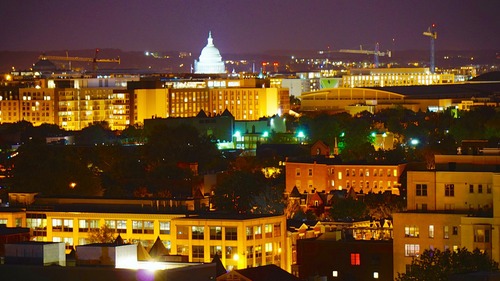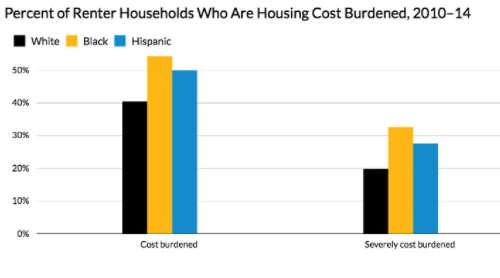If racial inequities didn’t exist, DC would look like this…
Across DC, black and Hispanic residents see a lot less socio-economic success than white residents, and many argue that’s because the playing field is not level when it comes to opportunities for success. The charts below show what DC would look like if minorities got a fair shake, according to a recent study.
There are big racial disparities in DC
Generally speaking, DC’s biggest pockets of black residents are in the east, Hispanic residents are in the north, and white residents are in the west. But according to DC’s Urban Institute, white homeowners have more freedom to choose where to live: between 2010-2014, they could afford 67 percent of all homes sold in the District and all homes in Ward 8. Black and Hispanic homebuyers, on the other hand, could only afford 9.2 percent and 29 percent of homes sold, respectively. s
Affordable rentals are also hard to come by for minorities, who the report says spend 30 percent or more of their monthly income on rent— an amount that experts say make a houshold “rent-burdened,” and that the report refers to as “cost burdened.” East of the Anacostia River, black residents can afford 67 percent of the rentals, but west of Rock Creek Park, only 7 percent of the rentals are affordable.
There’s a reason things are this way
While the study acknowledges that in recent years, the recession hit minority groups harder than it hit whites, it’s rooted in the acknowledgement that the above racial disparities are rooted in trends that have existed for much longer.
Minority groups have been traditionally barred from upward socioeconomic mobility by private actions and public policies for generations. Historically, it has been difficult for blacks to get mortgages, they were limited in who they could buy from, and they faced strict zoning restrictions. They were also prevented from getting better paying jobs, and when the federal government cut funding, poor black communities were usually affected most.
Over time, this has prevented minority communities from sharing in socioeconomic progress as a whole. This has meant a steeper barrier over time— one that the Urban Institute study calls inequitable.
Here’s how those inequities play out in terms of wages, and what DC would look like without them:
According the Urban Institute, “the living wage for a parent to support a two children should be $38.01/ hour, or $79,000/ year,” but a majority of minority families are below that threshold, around $75,000/ year. Only 44 percent of whites are below this threshold.
“East of the Anacostia, four out of five black residents working full time earned less than this living wage,” the report says, and 70% of black and Hispanic families working full time make below the living wage. However, with the many service industry jobs that minorities occupy, bridging this gap is difficult.
If DC were more equitable, poverty levels would look like this:
On average, the poverty level for black residents is at 26 percent, with Ward 8 being the worst at 30 percent; white poverty in DC, on the other hand, stands at 7.4 percent. The report also shows that white child poverty is virtually zero, while the poverty rate for black children is 38 percent and 22 percent for Hispanic children. If things were more equitable, the report says, “no child would be poor.”
Here’s what the employment picture would look like:
In DC, black unemployment is 5.5 times that of whites at 19.5 percent, which is above the national average of 16.1 percent. In a city where minority employment reflected white employment, “2,200 more Hispanic residents and 24,000 more black residents would be employed.”
The fact that many of DC’s fastest growing job sectors require some post secondary education has severe consequences for unemployment, too.
Minority communities also face steep inequities in education, which have far ranging effects on choice of housing, wages, employment, and even general health. Most whites ages 25 and u, have a high school diploma or GED and some level of college education, whereas 31 percent of Hispanics and only 17 percent of blacks don’t have a high school diploma or GED.
Further, only half of black and Hispanic communities have some level of education beyond high school. If the education gap didn’t exist, according to the study, 50,000 black and Hispanic residents would have at least a GED, and almost 98,000 black residents would have some post secondary education.
Changing all of this would raise the quality of living for everyone
A more racially fair society, the study says, would have substantial economic benefits for everyone. When people earn more they invest and spend more, which would benefit local businesses and education. In fact, they estimate that “DC’s economy would have been 65 billion dollars larger in 2012”, if many of these inequality gaps were closed.
However, the limit of this data analysis is in showing what, exactly, equality looks like. Citizens and policymakers need to understand how and why this inequality persists today and pursue policy agendas that would actually close these gaps.
What agendas do you think policy makers should pursue to close the racial inequality gap?
Note: Some readers have reported that when viewing this post expanded on the home page, the embedded tool doesn’t work. It should work if you are viewing the post on its own page; click here to go there.
Correction: This post previously omitted a word, saying “31 percent of Hispanics and only 17 percent of blacks have a high school diploma or GED” when those figures are for the percentage of each population that does not have a diploma or GED.


